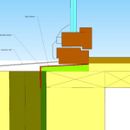Window sill detail
Attached are my “current” elevation and 3-D details for my “innie” window install. I recently added the beveled sill.
Do you think I need to take that beveled sill to the front edge of the Roxul so it will drain down the rainscreen? Any comments on the rest of the detail?
Thanks.
GBA Detail Library
A collection of one thousand construction details organized by climate and house part











Replies
Trying the elevation attachment again.
Jonathan,
The first two questions I asked myself are: (1) Where is the WRB? and (2) Where is the sill pan?
I concluded that (1) The Zip sheathing is the WRB, and (2) the Siga Fentrim tape is the sill pan. Did I guess correctly?
My online research reveals that Siga Fentrim is an air-sealing tape that is usually recommended for the interior side of a window. I don't know if it is intended to resist liquid water or to act as a sill pan. Remember, a sill pan needs to act as roofing. It needs to be watertight and long-lasting. So you might want to research the use of Fentrim as a sill pan.
Q. "Do you think I need to take that beveled sill to the front edge of the Roxul so it will drain down the rainscreen?"
A. No. The beveled sill is just a shim. It is a shim that is designed to be a smooth surface on which you install your sill pan.
Q. "Any comments on the rest of the detail?"
A. In addition to my earlier point -- that Fentrim tape may not be the best choice for a site-built sill pan -- you could improve the detail for the aluminum sill by turning up the sill at the vulnerable bottom corners of the windows. You could incorporate vertical legs to the flashing at these vulnerable corners, and you could cover the vertical legs of the aluminum with your exterior jamb extensions.
Martin,
Thank you and you have guessed correctly.
There are a couple versions of the Fentrim, including a black one that is for exterior air and wind-driven rain sealing. I am lucky to have a local Siga employee who is very knowledge and who has visited the site a few times already. He told me to use the black Fentrim for sealing the Zip/mud sill/foundation wall connection and that I can use the same tape for the window RO and I will confirm that with him.
For the beveled sill, I am planning on using Boral which will not absorb water and is rot and mold resistant.
The aluminum sills are being provided by the window manufacturer. I will check with them to see if they can oversize them slightly so we can turn then up at the jam extensions.
Thanks.
Martin,
I confirmed with Siga that the Fentrim is to be used for the RO. It is the same tape I am using for the mud sill in the attached picture. This tape has a fabric like exterior and is very strong and sticky. I find it almost impossible to puncture, unlike Zip. Siga also told me that I can use Wigluv for the jambs and header if I want to save few bucks, but the Fentrim is clearly the more robust of the 2 tapes.